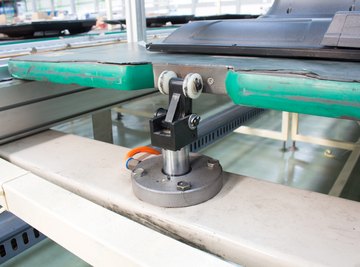
A pneumatic cylinder is a sealed metal tube containing a piston; when you feed pressurized air to the tube, it forces the piston in or out. A rod connected to the piston supplies force from the cylinder to some external object or mechanism. Two main factors affect the force the piston exerts: the pressure of the air supply and the piston’s area. The greater the force, and the greater the area, the more force the piston is capable of. Although you can use an online calculator to find the force, you can also calculate it yourself in a few simple steps.
Enter the diameter of the piston in inches in your calculator. Divide this number by two to obtain the piston’s radius. For example, imagine a pneumatic cylinder with a diameter of two inches. Two divided by two gives a radius of one inch.
Square the radius using the calculator’s “x2” key or by multiplying the number by itself. In the example, the radius is one inch. Squaring one gives a result of one.
Multiply the result of the previous step by the number pi, or 3.1416. The result is the piston’s area in square inches. Continuing the example, one times 3.1416 equals 3.1416 square inches.
Subtract 14.7 psi, or atmospheric pressure, from the pressure of the air supply. If your air supply has a pressure of 100 psi, then 100 psi - 14.7 psi equals 85.3 psi.
Multiply the result of the last step by the piston area to find the pneumatic cylinder force. For example, 85.3 psi times an area of 3.1416 square inches gives a force of 268 pounds.
References
About the Author
Chicago native John Papiewski has a physics degree and has been writing since 1991. He has contributed to "Foresight Update," a nanotechnology newsletter from the Foresight Institute. He also contributed to the book, "Nanotechnology: Molecular Speculations on Global Abundance." Please, no workplace calls/emails!
